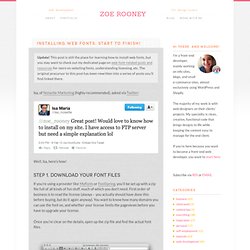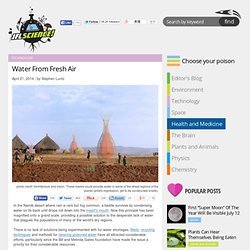

Installing Web Fonts, Start to Finish! Update!

This post is still the place for learning how to install web fonts, but you may want to check out my dedicated page on web font-related posts and resources for more on selecting fonts, understanding licensing, etc. The original precursor to this post has been rewritten into a series of posts you’ll find linked there. Isa, of Noisette Marketing (highly recommended), asked via Twitter: Well, Isa, here’s how! Step 1. If you’re using a provider like MyFonts or FontSpring, you’ll be set up with a zip file full of all kinds of fun stuff, much of which you don’t need. Once you’re clear on the details, open up the zip file and find the actual font files. There are usually four of them, as highlighted above. Step 2. Web development is all about making choices based on the details of the project and the context, so you have a few choies about where to put them on your server: Really, there are various combinations and permutations, but you get the idea. Step 3.
Src: url(' Step 4. Step 5.
Style Linking. Style linking is a somewhat confusing feature of the font-face spec.

It is however very useful when working with a font family that has the four standard styles of regular, italic, bold and bold italic. When a family is style linked, we can refer to just one font name, “FamilyName”, instead of each individual font style like “FamilyNameBoldItalic”. Another primary advantage to style linking is that it avoids the fake-bold or fake-italic that a browser could impose on a font. If a regular-weighted font has a <strong> tag applied, the browser makes the font bold using an algorithm.
Instead, using style linking we can tell the browser which font to use when the regular font is made bold. Try this demo. Here is the simplified CSS for a style linked font: Notice that the font-family property is the same name for all four fonts. Note: The normal weight must be at the top of the list! Putting the fonts to use: Further Hardening of the Bulletproof Syntax.
Emaol signatures. Adobe. Webtech. Advocacyss. Duckart. Why You Should Never Eat Tilapia. Why You Should Never Eat Tilapia Tilapia has become the ubiquitous fish in America today.

It’s cheap, not “fishy” tasting, boneless and skinless, and is hard to mess up by overcooking, which is a problem with many other fish varieties. However, the tilapia we’re eating is almost entirely a farmed fish, meaning you cannot find wild tilapia in any grocery store or on any restaurant menu. And the farming is usually done on an industrial scale, with thousands of fish being harvested every day. Their feed is not natural — in the wild, tilapia would eat algae and lake plants, but the farms fatten up the fish on GMO corn and soy pellets. Why Farm-Raised Tilapia is So Bad for You 1.Recent Studies have found that farm-raised Tilapia may cause more inflammation – Farm-raised tilapia has always been a popular source for fish, not only because it is widely available in the US, but it is also very inexpensive. Source Source Source Credit: Natural Cures Not Medicine Image food to avoidhealth Related Posts.
Water From Fresh Air. In the Namib desert where rain is rare but fog common, a beetle survives by condensing water on its back until drops roll down into the insect's mouth.

Now this principle has been magnified onto a grand scale, providing a possible solution to the desperate lack of water that plagues the populations of many of the world's dry regions. There is no lack of solutions being experimented with for water shortages. Wells, recycling techniques and methods for cleaning poisoned water have all attracted considerable efforts, particularly since the Bill and Melinda Gates foundation have made the issue a priority for their considerable resources.
However, many of these techniques have floundered; great on the page but unsuited to real world conditions. Those technologies that are cost effective represent only partial solutions, working well where a permanent water supply is available, but unsuited to regions where surface water vanishes in the dry season and groundwater is hard to reach.
Tech. Noticias. Juntas.